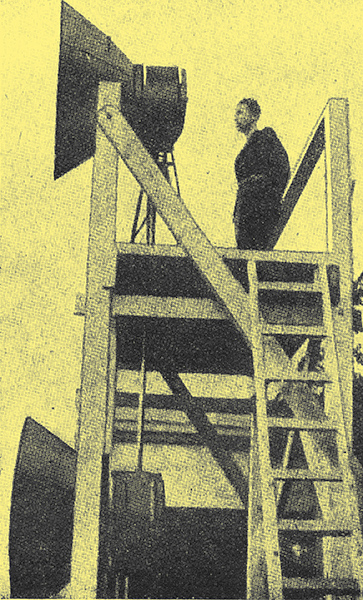|
RF scanning: French 'Obstacle Detectors'.
As Wireless World readers know, radar did not emerge fully fledged from nothingness during the war; its technique has been built up stage-by-stage from the contributions of many workers, and its history goes back for quite a respectable number of years. The main steps in the direct line of development have already been described in our pages, but as time goes on many other early uses of the radio echo principle will doubtless come to light.
British Patent No. 292,185, applied for by John Logie Baird as long ago as 1926, describes an arrangement that bears on the face of it a surprising resemblance to H2S, one of the most refined and highly developed applications of modern radar. Baird pointed out that wireless waves can be reflected and refracted like visible light waves, and contemplated 'a method of viewing an object consisting in projecting upon it electromagnetic waves of short wavelength'. Reflections from the object were passed through a scanning device to a receiver. The output of this receiver was to be used for modulating a source of visible light. A spot of light projected from this source would traverse a screen 'in synchronism with the exploration of the object'. The most obvious difference between Baird's scheme of 1926 and the present-day H2S is that scanning was done on the receiver side, and not by exploring the object with the transmitter beam.

The Sainte Adresse (Havre) experimental obstacle detector. The two parabolic reflectors explored a large sector.
French, technicians were early in the radar field, and it would seem that the first commercial application of the principle was in the 'obstacle detector' installed aboard the Novmandie in I935. In a general review of French technical progress, including that made under great difficulties during the German occupation, P Brenot, of the Société Française Radioélectrique, gives some interesting sidelights on early radar work. In this review, published in LOnde Eleotrique for September, 1945, there is a short description of an experimental 'obstacle location' station installed in 1936 by SFR at the entrance to the port of Havre. The apparatus worked on decimetre waves.

The surprisingly modern-looking 'display' is also shown. The series of traces indicate echoes from a tug; they grow in amplitude up to the time that the tug cuts the axis of the projector, which was fixed for this test. The trace length represents a total distance of 10 km ; the measured distance of the tug is here about 4 km. (From LOnde Electrique.)
|